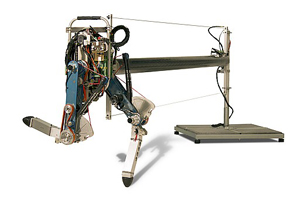

Holland’s Delft Robotics Institute has developed robots that can help humans in day-to-day activities and in matters involving the aging of society (Delft TU)
Holland’s Delft Robotics Institute has developed robots that can help humans in day-to-day activities and in matters involving the aging of society.
Holland’s Delft Robotics Institute has developed robots that can help humans in day-to-day activities and in matters involving the aging of society.

Holland’s Delft Robotics Institute has developed robots that can help humans in day-to-day activities and in matters involving the aging of society (Delft TU)
By Heitor Shimizu, from Delft*
Agência FAPESP – A research group at the Robotics Institute at Delft University of Technology in Holland is working on problems normally resolved by infants in days or months or before their first birthday .
These problems involve simple actions that are generally ignored by those performing them, such as how to get up, walk, see, extend one’s arms or open one’s hand to grab an object. But these and other movements involve extremely high complexity, as people with physical deficiencies or health problems can attest.
One of the Robotics Institute’s creations is Phibes, a robot that not only walks but also runs. It does not move freely like other walking robots developed by research institutions in several other countries. Phibes moves in circles around a metal bar mounted on a pedestal.
Phibes does not have a head, torso or arms, only hips and legs. It also does not have feet but rubbery ends that touch the ground. When it runs, it reaches speeds of 3.6 km/h, leaving it in Usain Bolt’s dust in a competition, but that is enough for now for researchers at the Dutch institute.
“The research proposals with Phibes and other similar robots are not to create moving machines but to broaden knowledge regarding the act of walking and running as practiced by humans. This knowledge is essential so that we can develop, for example, prostheses or other devices that should help improve the quality of life of people with locomotion difficulties, ” said Robert Babuska, director of the Robotics Institute.
Babuska explains that the institute conducts research bringing together several areas of knowledge to address the modern robotics aspects that he considers important, technical or practical.
“We build robots, but we also develop computer systems to make them [the robots] work. Among the areas of research that we conduct are man–robot interaction, biodesign, cybernetics, spatial presence, autonomous control and machine language,” he explained.
According to Babuska, the main scientific challenge of the institute – which has 85 researchers and doctoral and postdoctoral students – is to help humans to work efficiently in environments such as homes or offices.
“We believe that robotics will be the next big step in the digital revolution, which will promote an impact with precedents in the manner in which we live. Robotics can respond to some of the main challenges of the 21st century, such as lack of specialized labor, and assisting with or carrying out dangerous or harmful tasks. Robots can also offer an alternative to challenges such as the aging of society,” he said.
Among the alternatives that Delft researchers studied to help the elderly are robots that remind their owners to take medicine or measure their blood pressure – data that can be submitted to health centers via the Internet or a cellphone – and robots that serve as a support by moving through the home or simply keeping an individual company by interacting with him or her.
In addition, with respect to research on interactive robots, the Dutch institute focuses on two major areas: “robots that work” and “robot swarms”. The first involves systems of industrial applications, especially in areas such as foodstuffs, agriculture, construction and logistics. One example is a series of mechanical arms and legs used to separate vegetables on packaging assembly lines.
Robot swarms involve systems composed of diverse units of floating autonomous vehicles – not controlled at a distance but moving in accordance with their environment and installed programming – that help perform activities such as environmental monitoring, logistics, ship and freight tracking, and rescue in cases of accidents and natural disasters.
* The reporter traveled upon the invitation of the NL Agency, a service of the Dutch government.
Republish
The Agency FAPESP licenses news via Creative Commons (CC-BY-NC-ND) so that they can be republished free of charge and in a simple way by other digital or printed vehicles. Agência FAPESP must be credited as the source of the content being republished and the name of the reporter (if any) must be attributed. Using the HMTL button below allows compliance with these rules, detailed in Digital Republishing Policy FAPESP.





